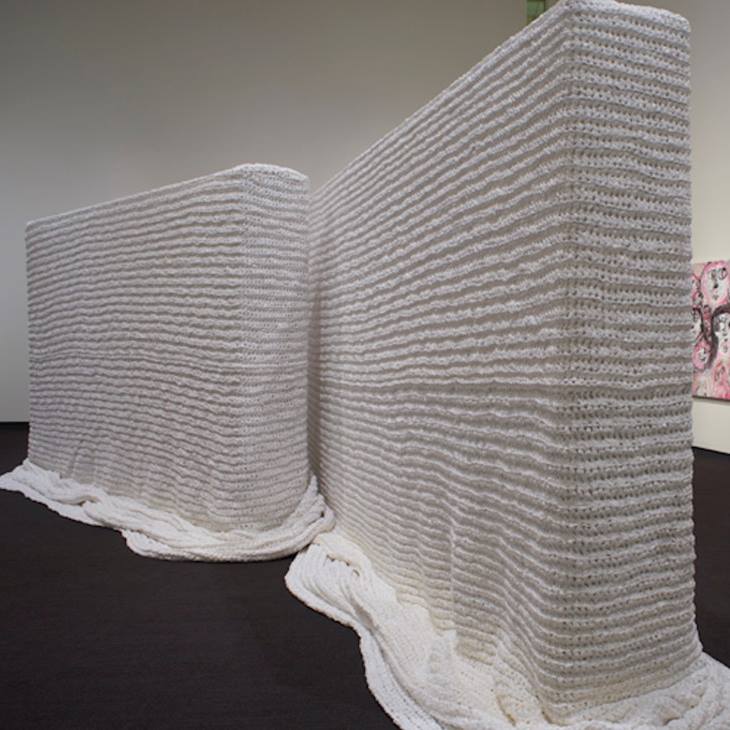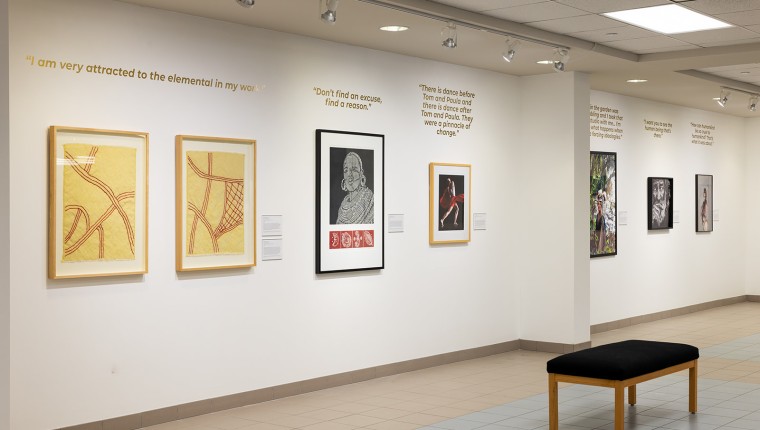in Tampa Bay
Through February 29
Free
Gallery3@HCC
Dale Mabry Campus, Tampa
3rd Floor – Learning Resources Building
Details here
Over the past four decades, Hillsborough Community College’s Permanent Art Collection has fostered strong connections between the college and the Tampa Bay arts community.
Oral history interviews with working artists add richness to the work on view. The work and aims of much-loved artists who have passed away are remembered through the words of close collaborators.
This is the second in a series of features sharing excerpts from the amazing oral history interviews Hillsborough Community College is collecting to preserve and honor the work of vital visual artists in our community.
Artists in this exhibition include – Suzanne Camp Crosby, Aneka Ingold, Aimee Jones, Akiko Kotani, Tom Kramer, Tracy Midulla, Wanda Raimundi-Ortiz, Renatto Rampolla, Frank Rampolla, Babs Reingold, Omar Richardson, Emiliano Settecasi, Kirk Ke Wang and Ruby C. Williams.
These transcripts are gently edited for readability.

Akiko Kotani
I would say that ever since I can remember, even as a child, this is how I was – how I am today, I feel I was then.
My mother had difficulty with me because being Asian also, I was expected to behave in a certain way. I never could. And for some reason, my mother always gave me room to explore.
I mean, I just am so happy that she did that because ever since I was a kid, I had incredible curiosity. I was very bright, but I had incredible learning disabilities. I was also a professor, you know, for 20+ years. And just because someone is right in one area doesn’t mean that they can be right in all areas. We know this, okay. But growing up, I could not read. That I became a professor is some kind of miracle.
But a person who is bright, resourceful, and creative like I was, we tend to compensate for our losses and we go with what we have. And that is how I was able to manage my difficulties.

So when I was a professor, I was given many students that had learning disabilities. When they found out how successful I was with students with learning disabilities, they sent them all to me and I loved it. Because intuitively I really understood what they were going through, and that all we had to find was where they were – where their overabundance lay. Once we found that, everything else came into place.
And so, ever since I was born, I’ve always had a very strong trajectory towards this way of living, being curious, being bright – but not bright in the way that was according to our educational standards. And I just simply, by trial and error, found my way to where I am today.
And it was being an artist that was the most fulfilling avenue for me. And so, I just put all my energies into being an artist.

I’m 82 now, because I’ve been at this a long time and I consider myself a long-distance runner because I’m still producing work.
And so, when my husband and I decided to live in Florida my primary thought was “Hooray, I can retire from art!!” Because for me it really was all-consuming and it took quite a bit of my energy.
Well, I came here and, lo and behold, I found a community that liked my work [laughs]. So I said, “All right, let’s try this out.” And so here I am, I am still producing work. I’ve been invited to show here in group shows and there for one person shows.

I’ve always said to my students, “If you want something you have to ask. The worst thing that can happen is no. And you can get over it.”
Ask “how does an artist have a show in this space?” Because for an artist, that’s the last thing they would do. They’re so afraid, they’re so scared, it’s a very natural reaction. But you never know, they might want to show your work.
Research is very much a part of doing artwork. And I think that many young artists or even the public in general, they may think that artists, their head is kind of in the clouds, they just pour out this thing on the canvas, they don’t have a thought in their head – but it’s really quite the opposite.
If you look at the work of artists that are solid, that holds your interest for a long time – it’s because there’s a lot of thinking, a lot of thought, a lot of research, hard research behind what is done.
And so I would like the students to understand that all the work they’re doing with their liberal education, they may hate to go to one class and like another one – but they all add up to art, or whatever field they’re entering. It will all add to that.

Find a friend, and the first thing you should do is try to attend as many openings of events that you can.
Now something very interesting is going to happen if you do that. You will begin to see people, repeated people at these openings – and eventually you have enough courage to speak to them. Don’t be afraid to ask a question of anyone there.
Now, when you are brave enough, speak to the artist that is showing. They are just as scared as you are at an opening, believe it or not. They have no idea how their art will be taken. Most artists have very poor self-esteem, believe it or not.
So if you go up and ask a very simple question, they will be very happy to engage and talk to you.
So this way you will begin to get to know people and then you can ask more questions, and you’ll get the hang of it. You will start to see how things are done.

Lynn Whitelaw on Tom Kramer
I remember Tom as a dance photographer for over 50 years.
As I got to understand dance better in the Tampa Bay area through Tom and Paula Kramer – and Helen French and others who were in the dance community – I realized that this was something extraordinary. The last 30 years of his life was primarily dealing with dance photography and he became the master of that realm.
I asked Tom to write an artist’s statement when he had a solo exhibit at the Leepa-Rattner. I’ll read this because I think it was wonderful.
He says – “When I was about eight, I cleaned out my father’s coal bin, found an old workbench. Borrowed three of my mother’s Pyrex pie plates, relieved her of two clothespins and proceeded to develop my first roll of film, taken with my prized new box camera.
“In the glow of a red light that I had found at the Five and Dime store, I witnessed incredible magic. Pictures miraculously emerge from a blank roll of film. My pictures.
“I was eight and I had found myself. I was a photographer.”
I thought, that has to be shared because that magic can’t happen again. I tell people, buy gelatin silver print photography because it is an art form that no longer will exist in our digital world. It truly was an art form, because it required a dark room and all of these elements to make it work. So it’s remarkable.

I think this is what’s consummate about someone who is an artist. They see challenges as opportunities. For Tom, he’s in the twilight of his life, he’s actually producing, and there was a big retrospective of his work for his 85th birthday.
That showed a lot of wonderful work, but then along comes COVID. And here he is, trapped at home, wanting to produce what he thinks is going to be the best work that he’s been able to do because he’s got the connections, and he’s got the equipment, and he’s got opportunities to work as he befriended so many artists.
Then COVID happens and everything shut down and he’s in the twilight of his life. So he looks at that challenge as an opportunity.

What he did was, working with Paul Wilborn and St. Pete’s Palladium Theater, was to go to the theater, be given full access to theatrical lighting and to – still they’re with masks and there’s very few people – engage dancers in doing improvised dance and he’s photographing from behind.

He’s not photographing a dance performance. He’s photographing dancers who are improvising and he gives them things like the mask series that he did or the long drapery that he did. He was constantly reinventing himself so he took the challenge of COVID and turned it into probably his most important body of work because it takes dance to a different realm.

Particularly with the COVID works, that really was the culmination of his artistic career, because it was that collaborative one-on-one.
Dance became Tom’s passion. It became his muse. What he defined as dance and the relationship of he as a photographer and the person as a dancer was that they were creating a sense of community and that they were in collaboration over their creativity. So it was to be an amalgam of this spirit.

His photography is in the collection of the Leepa-Rattner Museum of Art, the St. Pete Museum of Fine Arts, and the Florida Museum of Photographic Arts.
Don’t we all wish that at the end of our lives, we have these things that celebrate what we have accomplished?

There was a PBS Channel 3 Arts Plus that was done on Tom. What a wonderful documentation.
So his work will be shown in museums, his interest in dance will be shown on stages, and we have a wonderful visual legacy through the WEDU production.
So to be in your 80s and to really have that be your crowning time. What an honor.
– Lynn Whitelaw
You can find the full oral history transcripts here
just click twice on the page for each artist to open the text




